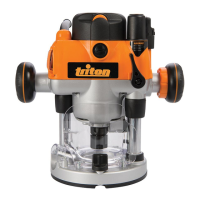5
stable platform. Holding the work by
hand or against your body is unstable and
may lead to loss of control.
• Do not force the router. Use the
correct tool for your application. The
correct tool will do the job better and
safer at the rate for which it is designed.
• Do not use the router if switch does
not turn it on or off. Any tool that
cannot be controlled with the switch
is dangerous and must be repaired. If
there appears to be a problem refer to
the “Trouble-shooting” and if necessary
contact a repair centre.
• Disconnect the plug from power
before making any adjustments,
changing accessories, or storing the
tool. Such preventative measures reduce
the risk of accidental starting.
• Store tool in a dry location, out of
reach of children and untrained
persons. This tool is dangerous in the
hands of untrained users.
• Maintain tools with care. Keep cutting
tools sharp and clean. Properly maintained
tools, with sharp cutting edges are less
likely to bind and are easier to control.
• Check for misalignment (ie.
excessive vibration), binding of
moving parts, or any damage that
may affect the tools operation. If
damaged have the tool serviced before
using. Many accidents are caused by poorly
maintained tools.
ADDITIONAL SAFETY
WARNINGS FOR
ELECTRICAL ROUTERS
• Never start the router while the
cutter is touching the workpiece.
• Ensure the cutter has completely
stopped before plunging to the collet
lock position.
• Do not handle cutters immediately
after use - they become very hot.
• Ensure the plunge spring is always
fitted when using hand-held.
• Only use router cutters designed for
woodwork, suitable for use between
8,000 and 21,000rpm.
• Only use cutters with a shank
diameter exactly matched to the
collet(s) supplied with this router.
(½" and ¼" for Australian, UK, USA,
Canadian & South African models.
½", ¼", 12mm, 8mm & 6mm for
Japanese models. 12mm & 6mm for
European & Korean models.)
• Extreme care must be taken not
to overload the motor when using
cutters with a diameter greater then
2" (50mm). Use very slow feed rates
and/or multiple shallow cuts to avoid
overloading the motor.
• Remove the plug from the socket
before carrying out any adjustment,
servicing or maintenance.
• Fully unwind cable drum extensions
to avoid potential overheating.
• When an extension cable is required,
you must ensure it has the right
ampere rating for your power tool
and is in a safe electrical condition.
• Ensure your mains supply voltage is
the same as your tool rating plate
voltage.
• Your tool is double insulated for
additional protection against a
possible electrical insulation failure
within the tool.
• Always check walls, floors and
ceilings to avoid hidden power cables
and pipes.
• After long working periods external
metal parts and accessories could
be hot.
• Handle router bits with care, they
can be extremely sharp.
• Check the bit carefully for signs of
damage or cracks before use.
Replace
damaged or cracked bits immediately.
• Always use both handles and make
that you have a firm grip on the
General Safety Rules

